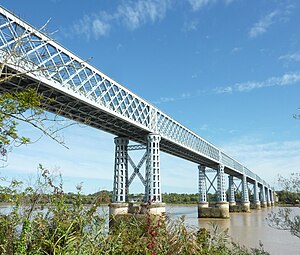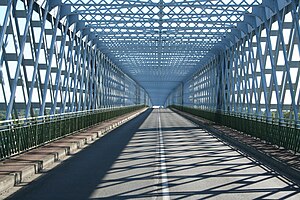Cubzac road bridge
Coordinates: 44 ° 57 ′ 42 " N , 0 ° 27 ′ 43" W.
| Cubzac suspension bridge | ||
|---|---|---|
| Crossing of | Dordogne | |
| place | Cubzac-les-Ponts , Gironde department | |
| overall length | 545 m | |
| width | 7.50 m | |
| Longest span | 5 × 109 m | |
| Clear height | 22.5 m | |
| opening | 1833 | |
| location | ||
|
|
||
The road bridge of Cubzac is one of the four bridges between the French places Cubzac-les-Ponts and Saint-Vincent-de-Paul in the Gironde department in the region Nouvelle-Aquitaine , the Dordogne cross. In French it has different names such as Pont de Cubzac , Pont routier de Cubzac , Pont routier de Saint-André-de-Cubzac (after the larger neighboring town) or Pont de Cubzac et de Saint-Vincent-de-Paul .
It was originally part of the national road 10 from Paris to Bordeaux and on to Hendaye on the Spanish border, but today only serves the 1010 departmental road from Saint-André-de-Cubzac to the suburbs of Bordeaux.
Long-distance traffic is taken up by the motorway bridge about one kilometer upstream, which was opened in 1974. The Cubzac railway bridge, completed in 1885, is about a kilometer downstream . Above the highway bridge is a bridge for the high-speed line of the TGV from Paris to Bordeaux.
Suspension bridge (1839–1869)
Crossing the approximately 500 m wide Dordogne with its occasional violent winds and tidal currents was always a dangerous undertaking. The ferries could handle the traffic soon no more. Napoleon therefore ordered a bridge to be built as early as 1812. In the political upheavals of the time, however, the plan went under. When the Pont de pierre was opened over the Garonne in Bordeaux in 1822 , the Dordogne was the last major obstacle on the road from Paris to Spain. In 1827 the company De Verges & Bayard de la Vingtrie , a competitor of the Seguin brothers , received the concession to build a suspension bridge , which was completed in 1833, but was not officially opened until 1839 by the Duke and Duchess of Orléans .
The suspension bridge planned by Jean-Baptiste Billaudel was a 545 m long structure with 5 openings of 109 m each, which had a clearance height of 22.5 m above the floods of the Dordogne. The Cubzac suspension bridge was probably the longest suspension bridge with the largest number of openings in a row of its time.
Six pairs of masonry piers, 5 m wide and 13 m high, founded on piles, formed the foundation for 28 m high, cast iron pylons on which the suspension cables rested, from which the 7.50 m wide girder hung. In addition to the suspension cables, ropes were stretched from the pylon tops in both directions to the points at which the deck girder hit the next pylon in order to stiffen the pylons. Long brick ramp bridges with 28 arches each were attached to the actual suspension bridge on both sides to bring traffic to the level of the bridge. Including these access ramps, the structure had a total length of 1545 m.
The suspension bridge did a good job, but there were significant vibrations in the deck girders right from the start, so that a weight restriction was introduced and heavy traffic had to take the detour via the bridge in Libourne , which opened in 1824 . During a severe storm in 1869, however, the vertical vibrations reached deflections of 2 m, which ultimately led to the collapse of a bridge span and serious damage to other parts of the bridge, so that it was no longer built.
Lattice girder bridge (1883–1944 / 1947)
| Lattice girder bridge from Cubzac | |
|---|---|
| Cubzac Bridge in 2012 | |
| overall length | 552 |
| Longest span | 6 × 72.80 m + 2 × 57.60 m |
| completion | 1883 |
| planner | Charles de Sansac ( Société Eiffel ) |
| On the bridge | |
After the suspension bridge collapsed, a new building was discussed for a long time. The first masonry work began in 1873, but work on the actual bridge did not begin until 1879, when Gustave Eiffel had prevailed with the project presented by his company in 1869.
The bridge consisted of wrought iron lattice girders , which were supported on cast iron pylons with a stone substructure. Eiffel had increased the number of pairs of piers to nine and thus shortened the spans , so that the bridge with a length of 552 m consisted of 6 fields of 72.80 m and 2 fields of 57.60 m. The access ramps could largely be used again. The lattice girders for the first three fields on each side were created and pushed in using the incremental launching method , a construction method that was largely unknown at the time. In the middle bays, problems with the flexible pylons were feared and the lattice girders were therefore cantilevered .
The bridge was opened in 1883. It withstood the storms and the increasing traffic of the following decades.
In 1944, at the end of World War II , the three northern bridges were blown up by German troops.
The reconstruction took place after a corresponding tender in the years 1945-1947 by the Anciens Établissements Eiffel under the direction of Jacques Eiffel, one of the grandsons of Gustave Eiffel. Care was taken to ensure that the appearance of the new section resembled that of the old bridge as closely as possible. However, the connection to the existing structure as was Gerber beam with a 44.80 m long suspended beam adapted to the different behavior of wrought iron, and balance of the steel carrier.
Web links
Individual evidence
- ↑ a b c d e Pont de Cubzac - 1839 in Base d'ouvrages en service ou construits au XIXème siècle en France on art-et-histoire.com
- ^ Société Bayard de la Vingtrie on art-et-histoire.com
- ↑ One of the engineers working on the construction of the bridge was Émile François Marie Martin (1794–1871), the father of Pierre-Émile Martin , who became famous through the Siemens-Martin process
- ↑ a b c d e Marcel Prade: Ponts & Viaducs au XIXe Siècle . Brissaud, Poitiers 1988, ISBN 2-902170-59-9 .
- ↑ a b c Viaduc dit pont de Cubzac (pont routier) on Base Mérimée




